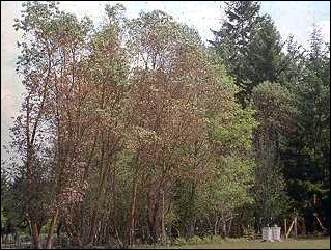Plant Data
Sheet

U.S. Forest Service
Species
(common name, Latin name)
1. Pacific Madrone, Madrono,
Madrona,
Arbutus menziesii
Range
1.
Climate,
elevation
1. Diverse climate: A.
menziesii can be found in climates with as little as 15” to as much
as 100” of rainfall per year. The can grow as high as 7000’ so long as
temperatures do not get too cold.
Local
occurrence (where, how common)
3. Drier lowland areas, comprising >20%
of the tree canopy
Habitat
preferences
2. Prefers rocky well drained areas, even a
lengthy drought period.
Plant
strategy type/successional stage (stress-tolerator, competitor, weedy/colonizer,
seral, late successional)
1. A. menziesii dominates after forest
fires and other major disturbance that leave an area without a seed source for
an old growth species.
Associated
species
1. Pinus
coulteri, Quercus chrysolepis, P. menziesii, and Umbellularia
californica.
May
be collected as: (seed, layered, divisions,
etc.)
4. Seeds can be collected, more commonly
new trees arise from root crown sprouts.
Collection
restrictions or guidelines
4. Berries ripen September through November
and may be collected then.
Seed
germination (needs dormancy breaking?)
4. Seed stratification is necessary to
break dormancy. Place seeds inside
a small plastic bag containing moist medium and store at a temperature just
above freezing for 35-45 days. Seed
should germinate in 10 days.
Seed
life (can be stored, short shelf-life, long
shelf-life)
4. Berries can be thoroughly dried and
stored at room temperature for 1 to 2 years. Seed should be extracted from berries,
dried, and stored in a sealed container at temperatures just above
freezing.
Propagation
recommendations (plant seeds, vegetative parts, cuttings,
etc.)
2. Best if sprouted new from old root mass
destroyed in a forest fire, if you wish to save one in your yard you might want
to burn it to the ground!
Soil
or medium requirements (inoculum necessary?)
4. A. menziesii is highly susceptible to
fungi, research indicated that bare mineral soil is the best method to
propagate.
Installation
form (form, potential for successful outcomes,
cost)
Considering
the tendencies of this species installation can be highly successful with
desired form being achievable through control, sometimes costly, of
environmental factors.
Recommended
planting density
4. The denser the planting the better the
form: Tall slender and graceful
trees result from communities where as individuals tend to be squatter. This is a result of the microclimate the
species establishes for itself.
Care
requirements after installed (water weekly, water once
etc.)
2. Water studiously the first three to five
years. Do not water when hot and
dry.
Normal
rate of growth or spread; lifespan
2. Slow growing, A. menziesii may reach
80’-100’ in height over a 200-250 year lifespan. Trunks may reach 3’ in diameter.
Sources
cited
- http://biology.fullerton.edu/courses/biol_445/Web/madrone.htm
- http://students.washington.edu/melliott/arbutus/990714thescooponmadronas.htm
- http://students.washington.edu/melliott/arbutus/madroneforest.html
- http://wpsm.net/Arbutus.pdf
- http://www.sannet.gov/street-div/pdf/treeguide.pdf
Data
compiled by (student name and date)
Rob
Wines